This post may contain affiliate links. Please read our disclosure policy.
How to make the most delicious Italian Roast Pork Loin stuffed with Amalfi lemon, fennel, white wine and garlic. Roasted to perfection it’s juicy, tender and full of flavour. Serve with roast potatoes or your favourite Italian side dish.
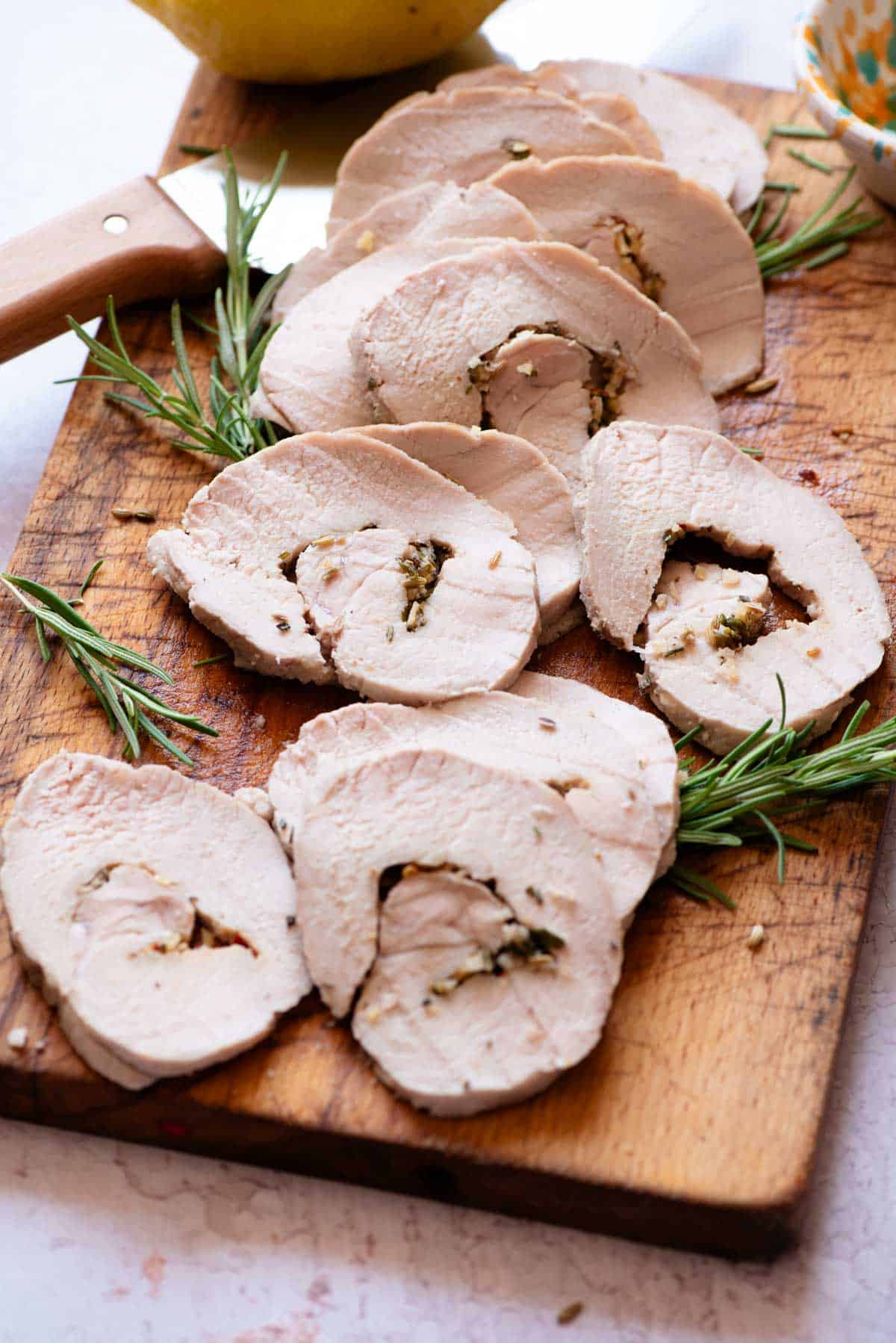
This Italian roast pork loin is a recipe we’ve had on repeat for months now. It’s so juicy and tender and packed full of flavour from zesty lemons, delicious herbs, garlic and white wine – you just know it’s going to taste good!
What’s better is it’s fairly simple to make you just need to season, roll and roast. The fresh and fragrant flavours in this roast pork loin make it undeniably delicious and perfect for every season.
Serve it with some Italian roast potatoes, green beans and arugula salad – delicious!
See the recipe below including notes on ingredients, step by step photos, tips, variations and a video tutorial. For the full printable recipe scroll to the bottom or click the recipe link below
Ingredients
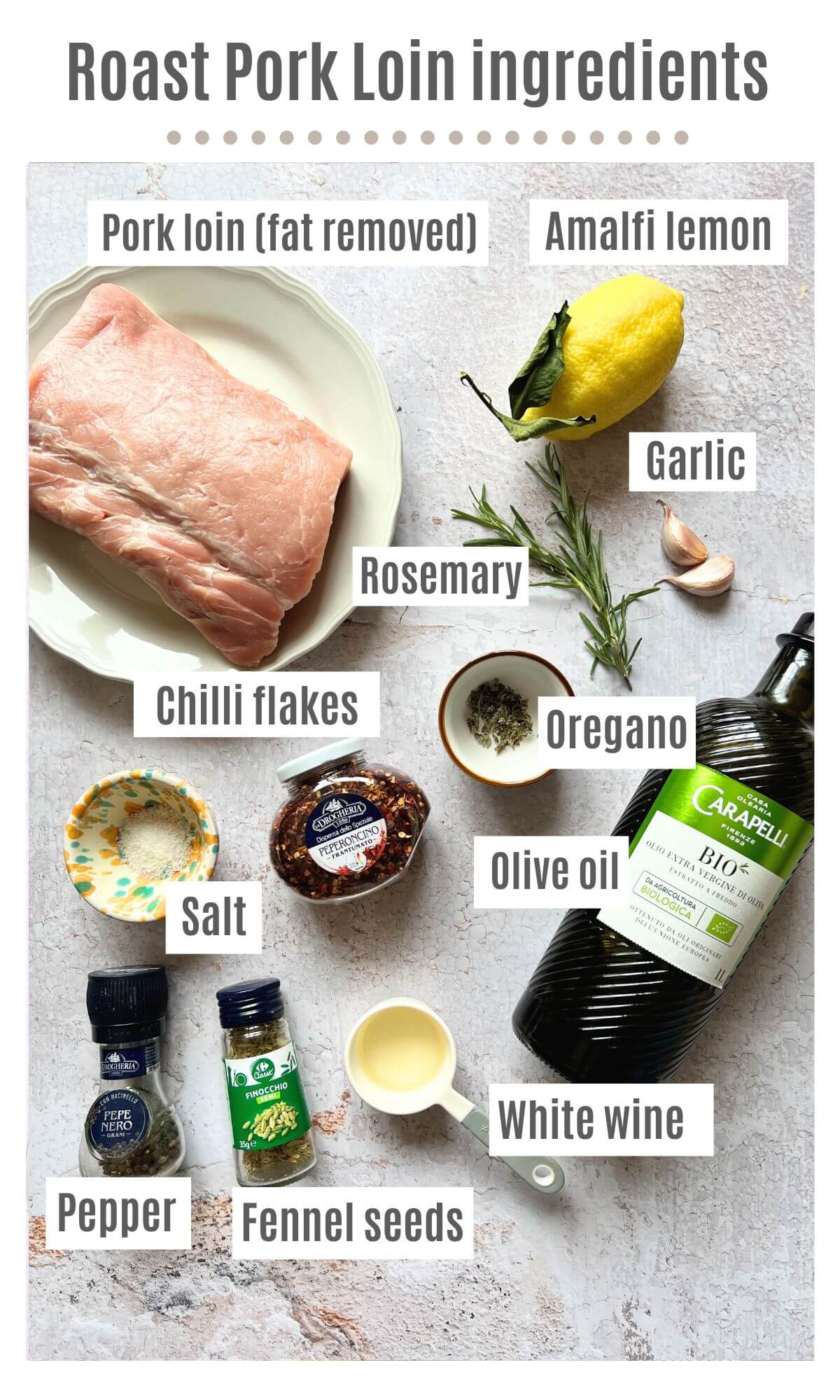
Pin this now to find it later
Pin ItIngredient notes and substitutions
- Pork loin – 1kg (2lbs) of pork (weight is after the fat has been removed) if you are buying the pork with fat on you’ll be looking for about a 1.5kg (3.3lbs) piece. Note: a pork loin is not the same as a pork tenderloin which is a completely different cut and has a much shorter cooking time.
- Lemons – we used Amalfi lemons in our recipe which is extremely fragrant and flavourful but if you can’t get your hands on Amalfi lemons don’t worry just use a good-quality unwaxed lemon.
- Rosemary, oregano & fennel – this mix of herbs gives the pork the most delicious flavour. Use fresh rosemary, chopped and dried oregano and fennel seeds.
- Garlic – fresh garlic is a must (don’t use ground/powdered garlic).
- White wine – we used white Vermentino wine but any dry Italian white wine will do (if you don’t want to use alcohol just leave it out).
Step by step photos and instructions
Remove fat – this step is just in case you buy a pork loin with the fat attached. Use a large sharp knife to remove the thick layer of fat being careful not to remove any meat.
Once the fat is removed use the same knife to remove any sinew (silver skin) that is over the top of the pork (photos 1-4).
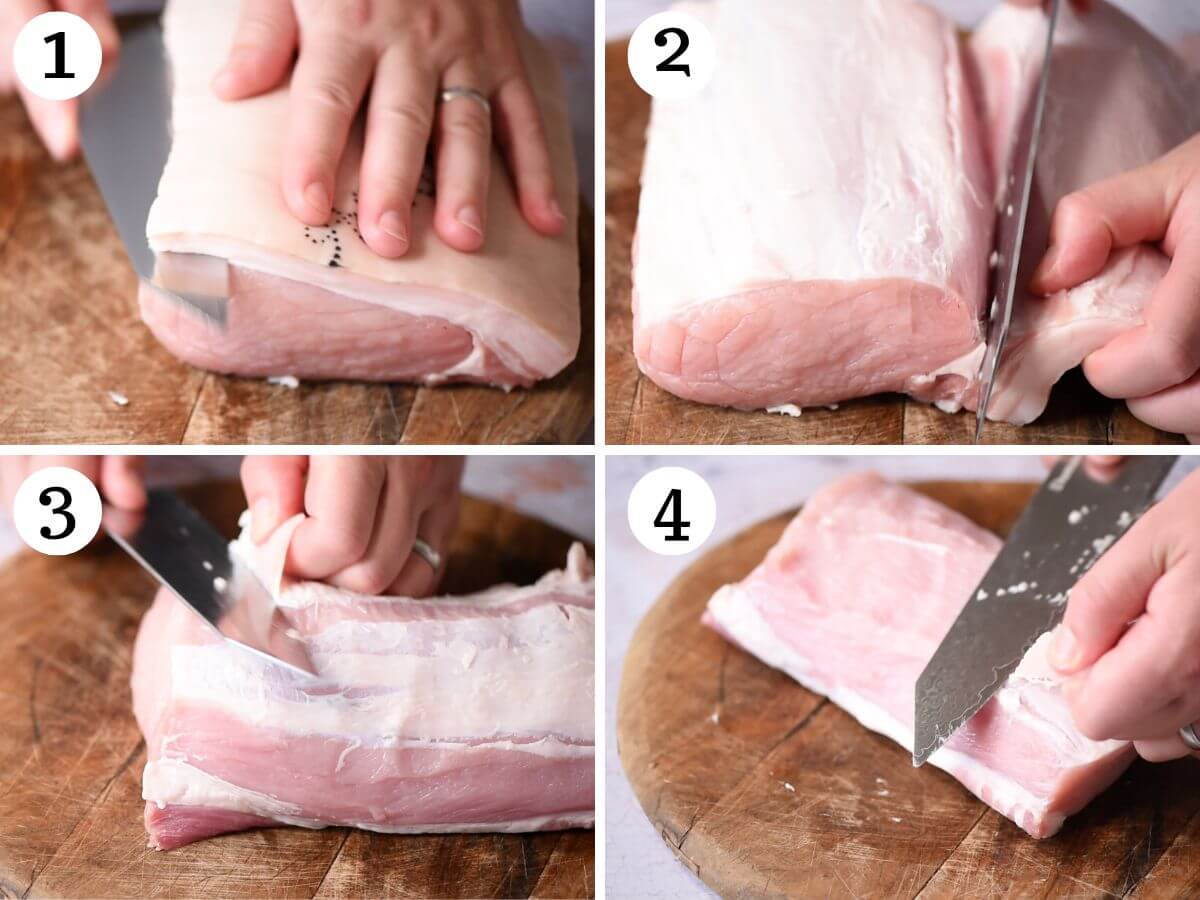
Prepare and season – Cut the pork loin down the middle lengthways so it’s open like a book (don’t cut right the way though it should still be one whole piece). Place a piece of plastic wrap over the pork and bash the pork with a meat mallet or rolling pin a few times all over to tenderise the meat and make it an even thickness. Discard the plastic wrap (photos 5-7).
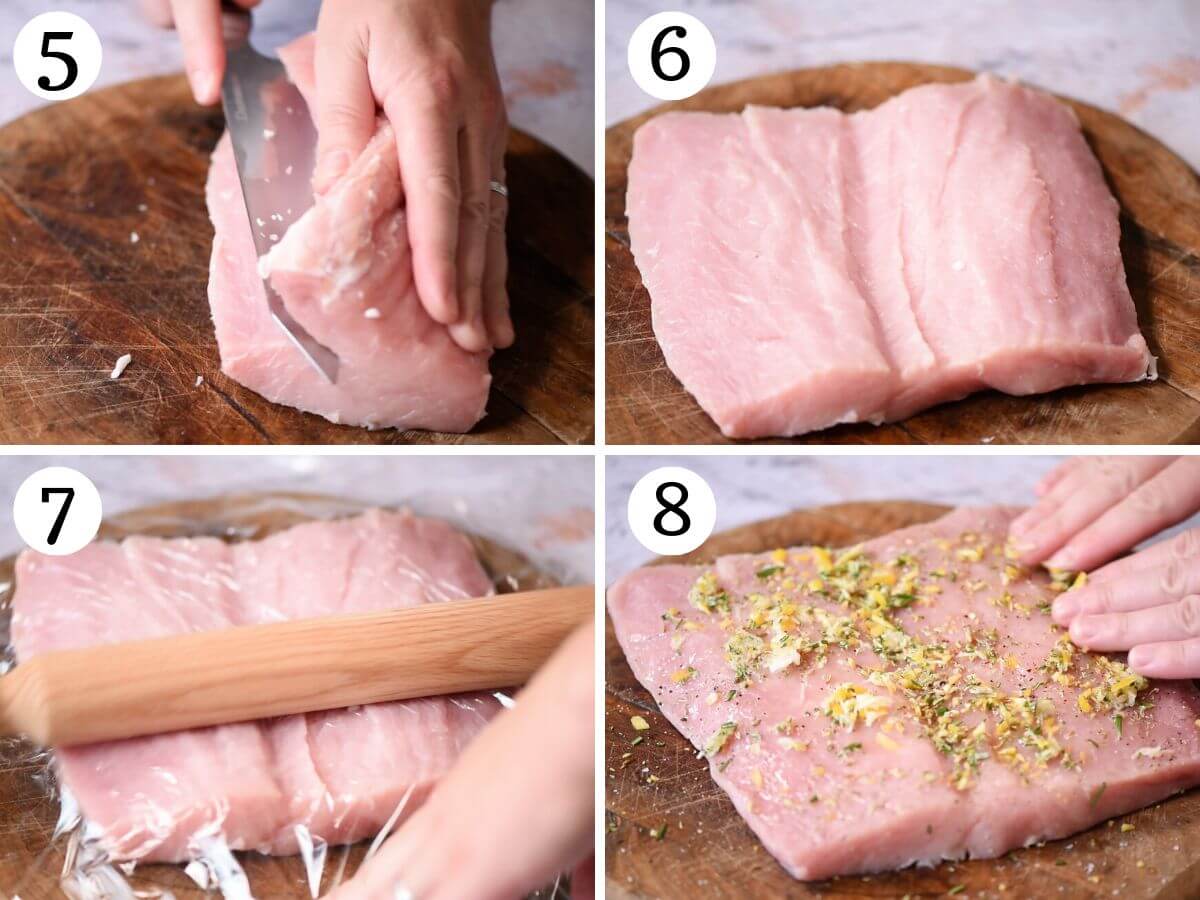
Using a mezzaluna or knife finely chop the lemon zest and rosemary together.
Sprinkle the pork with sea salt flakes (you can also use regular salt) then sprinkle over the lemon zest, rosemary, grated garlic, oregano, red pepper flakes and a pinch of black pepper. Finally, drizzle the white wine and olive oil over the pork and rub everything together (photo 8).
Tightly roll the pork lengthways from one end to the other and secure it with kitchen string. You can do this by tying loops of string at each end then about ½ an inch apart across the pork (photos 9-11).
Once the pork is secure with kitchen string sprinkle more sea salt flakes and fennel seeds over the top of the meat and drizzle with 1 tablespoon of olive oil and rub it all over (photo 12).
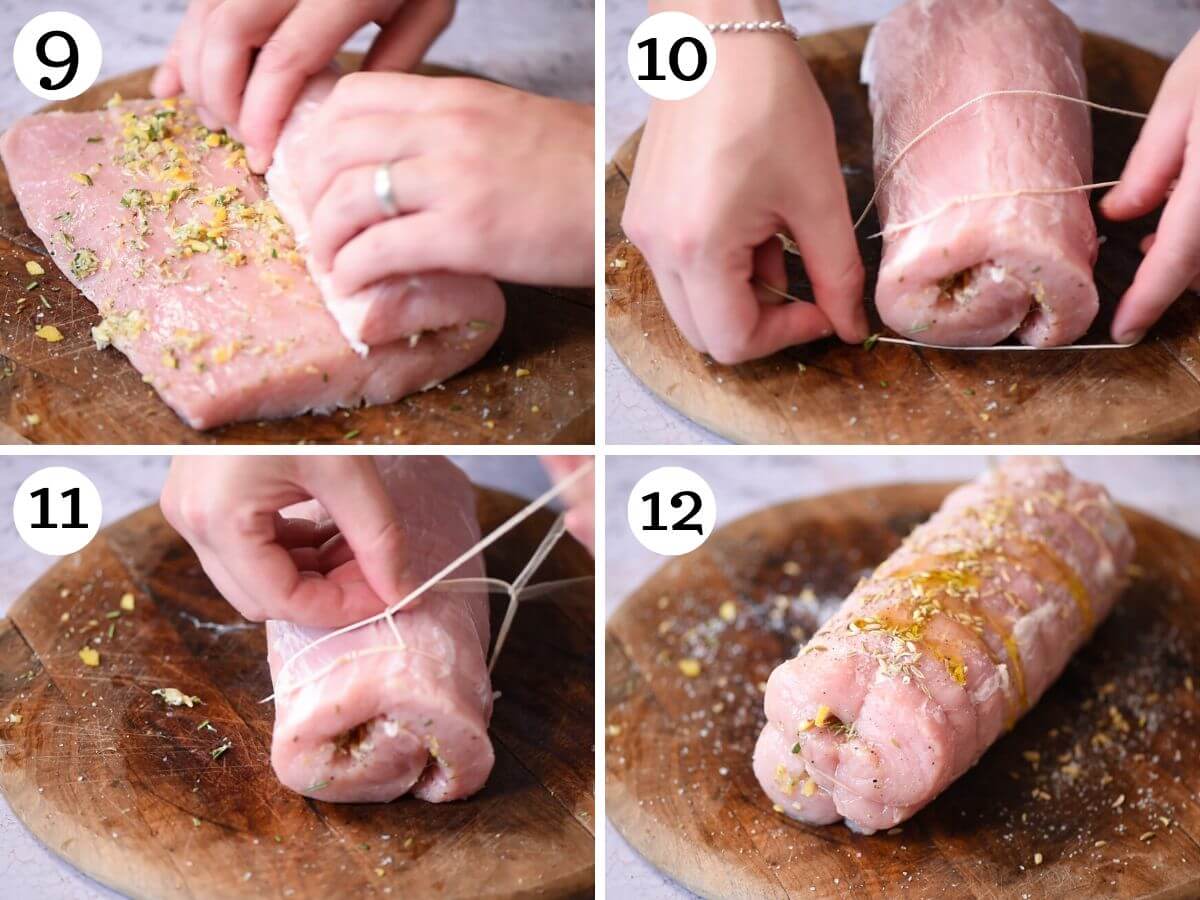
Tip: If you have time place the pork in the fridge for 2 hours to overnight to infuse the flavours but it can be roasted right away.
Thickly slice the onion and place in a roasting tin as a bed for the pork to sit on. Place the pork on top and cover with the baking parchment (photos 13 and 14).
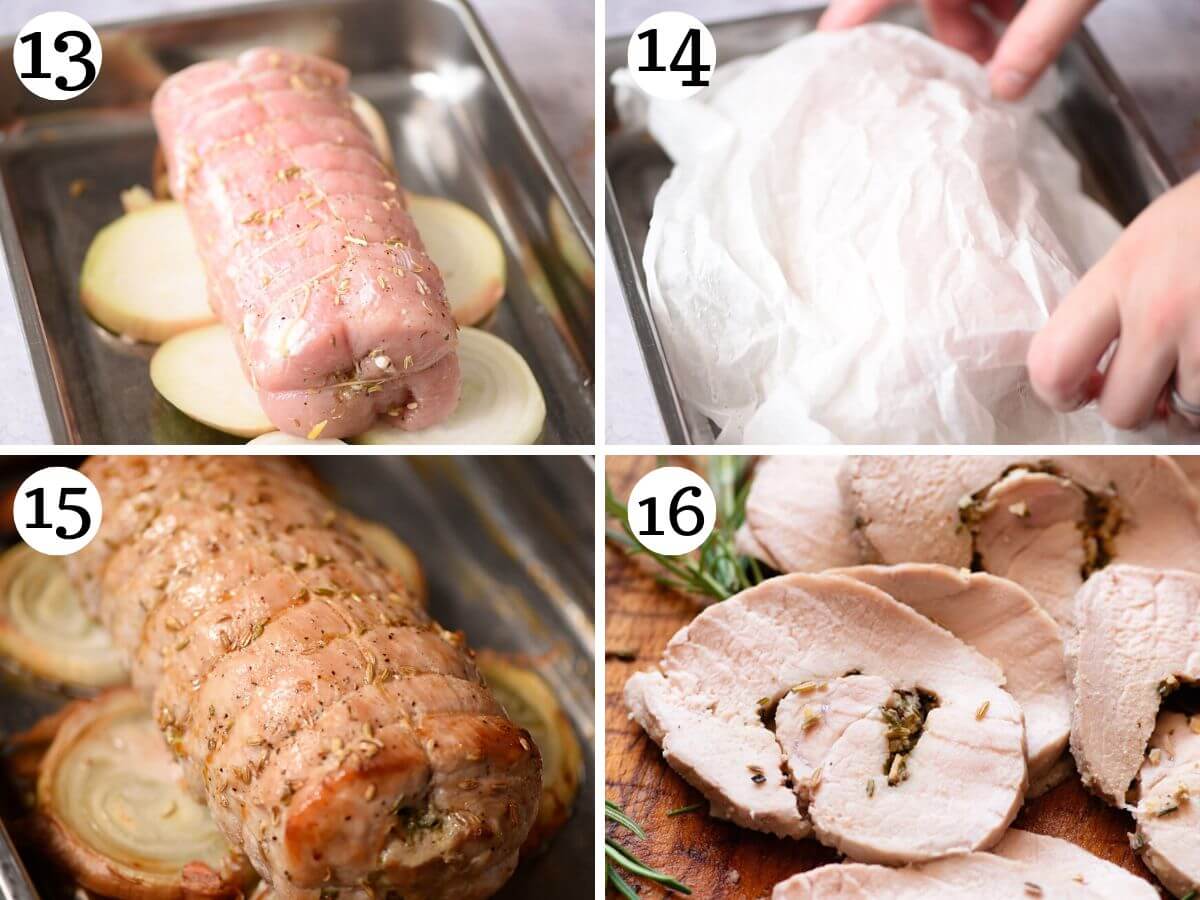
Roast for 30 minutes covered then remove the baking parchment and roast for another 40 minutes uncovered (photo 15).
Remove from the oven, cover with foil and let it rest for 20 minutes before slicing and serving (photo 16).
How to tie the pork
The simplest way
This way is really simple and easy. Start by tying a loop around each end of the pork, make sure to tie a tight knot without it digging into the pork.
Continue tying loops by cutting new pieces of string spaced about 1/2 an inch apart across the pork loin.
The technical way (more fiddly but tighter)
This is the more technical way to tie up a piece of meat and it’s not the easiest thing to explain without making something fairly simple sound complicated. See our step-by-step photos and video tutorial for a visual explanation.
- First, tie a small loop at the end of your kitchen string (make sure you cut one long piece of string for this so there is enough). Place the string underneath the meat at one end, feeding the end of the string through the loop and pull it tightly at the top.
- Pull about 1/2 an inch of the string straight up the centre of the pork holding it in place with your finger. Place the string back underneath the meat and feed it under the piece your finger is holding and pull it tight.
- Continue doing this every half inch until you reach the end of the pork.
- Finally, pass the string along the centre of the bottom of the pork going under each loop and tying a knot at the end.
- Phew! Like I said, this is a difficult thing to explain without making it sound over complicated when really, when you do it once or twice it’s not complicated at all. If you’d like to learn how to do this I recommend watching our video tutorial which shows the process clearly.
- It’s important to note that this is not essential but tying it is so if this seems overwhelming and complicated go with the easy and simple method above!
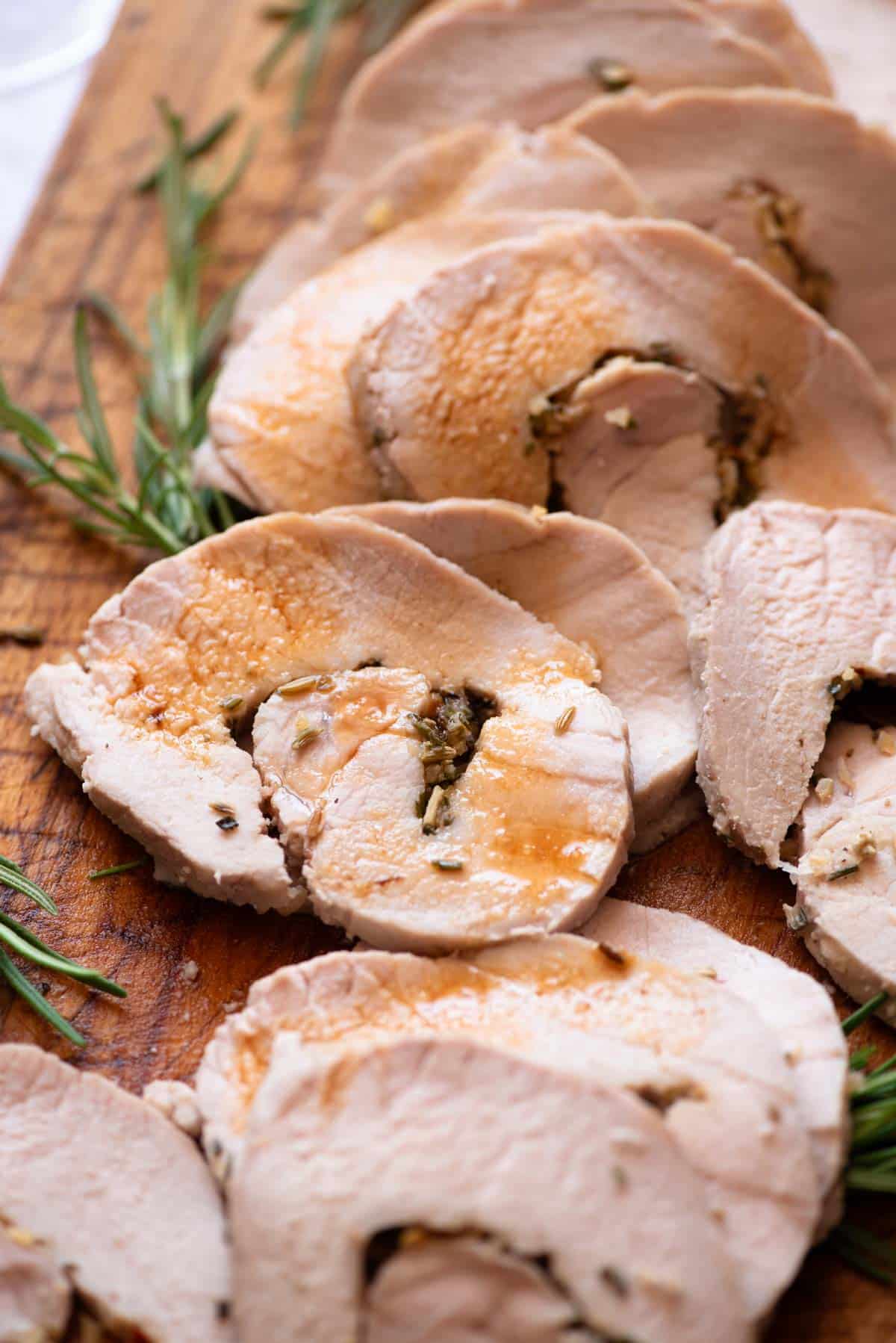
Recipe tips
- Trimming the sinew (silver skin) – after you have removed the thick layer of fat you’ll need to remove any remaining sinew so you have a lean piece of meat. To do this, keep your knife level when trimming the sinew so you don’t dig into the loin and cut the meat (a sharp knife helps).
- Using a bed of onions – this not only adds flavour to the pork but it’s important for roasting the pork evenly. Cut 1-2 onions in thick slices (about 1/2 inch thick) removing the round ends so the pork sits level.
- Baking parchment – scrunch the baking parchment in your hands then run it under cold water to dampen it. This will create a cartouche for the pork, keeping the moisture in without overcooking it.
- Resting the pork – it’s so important to rest the meat to allow the juices to absorb back into the meat keeping it juicy and flavourful. Don’t worry it will still be hot.
Recipe FAQs
If there is a lot of sinew left on the loin it will tighten during cooking so it’s important to remove as much as possible so you have a lean pork loin. If you can buy your pork with this already removed you can skip this step.
Yes, place slices of pork on a small baking tray or heat-proof dish and cover with foil. Bake at 180C (350F) for about 10 minutes until heated right through.
The pork will keep well in the fridge (covered) for around 3-4 days.
Yes, cooked pork can be frozen, defrosted then reheated.
More Italian roasts to try
If you’ve tried this Italian Roast Pork Loin recipe or any other recipe on the blog then don’t forget to rate the recipe and let me know how you got on in the comments below, I love hearing from you! You can also follow us on Facebook, Instagram and Pinterest or sign up to our Newsletter to see more of our delicious food
Step By Step Photos Above
Most of our recipes come with step by step photos, helpful tips and tricks to make it perfectly first time and even video!
Italian Roast Pork Loin with Amalfi Lemon & Fennel

Equipment
- Plastic wrap (cling film)
- Kitchen string
- Meat mallet or rolling pin
- A damp and crinkled piece of baking parchment for covering the pork
- Aluminium foil
Ingredients
- 1 kg pork loin, (weight is after fat removed, see note 1)
- 1 pinch chilli flakes, (red pepper flakes)
- ½ Amalfi lemon peel, or other unwaxed lemon
- 1 teaspoon oregano
- 1 teaspoon rosemary
- 1 teaspoon fennel seeds
- 2 garlic cloves, finely grated or minced
- 1 large onion or 2 small
- 1 tablespoon Italian white wine, (e.g Vermentino, Pinot Grigio, Pecorino)
- Olive oil
- Sea salt flakes and black pepper
Instructions
- Pre-heat the oven to 180C (350F).
- Cut the pork loin down the middle lengthways so it’s open like a book (don’t cut right the way though it should still be one whole piece). Place a piece of plastic wrap over the pork and bash the pork with a meat mallet or rolling pin a few times all over to tenderise the meat and make it an even thickness. Discard the plastic wrap.
- Using a mezzaluna or knife finely chop the lemon zest and rosemary together.
- Sprinkle the pork with sea salt flakes (you can also use regular salt) then sprinkle over the lemon zest, rosemary, grated garlic, oregano, red pepper flakes and a pinch of black pepper. Finally, drizzle the white wine and olive oil (1 teaspoon) over the pork and rub everything together.
- Tightly roll the pork lengthways from one end to the other and secure it with kitchen string. You can do this by tying loops of string at each end then about ½ an inch apart across the pork (see our step-by-step photos and recipe video for tying up the pork using butcher's knots, see note 3).
- Once the pork is secure with kitchen string sprinkle more sea salt flakes and fennel seeds over the top of the meat and drizzle with 1 tablespoon of olive oil and rub it all over.
- If you have time place the pork in the fridge for 2 hours to overnight to infuse the flavours but it can be roasted right away.
- Thickly slice the onion and place in a roasting tin as a bed for the pork to sit on. Place the pork on top and cover with the baking parchment.
- Roast for 30 minutes covered then remove the baking parchment and roast for another 40 minutes uncovered.
- Remove from the oven, cover with foil and let it rest for 20 minutes before slicing and serving.
Video
Notes
-
- Pork weight – 1kg/2lbs is the weight of the pork with the fat removed. If you buy a pork loin with the fat attached you’ll need a 1.5kg/3.3lb piece of meat.
- Trimming the sinew (silver skin) – after you have removed the thick layer of fat you’ll need to remove any remaining sinew so you have a lean piece of meat. To do this, keep your knife level when trimming the sinew so you don’t dig into the loin and cut the meat (a sharp knife helps).
- Tying the pork – there are two ways you can tie the pork. You can tie it using butcher’s knots which keep the meat secure and in shape or by simply tying loops across the length of the pork. Don’t worry about being able to use butcher’s knots too much, the important thing is that the pork is secure.
- Using a bed of onions – this not only adds flavour to the pork but it’s important for roasting the pork evenly. Cut 1-2 onions in thick slices (about 1/2 inch thick) removing the round ends so the pork sits level.
- Baking parchment – scrunch the baking parchment in your hands then run it under cold water to dampen it. This will create a cartouche for the pork, keeping the moisture in without overcooking it.
- Resting the pork – it’s so important to rest the meat to allow the juices to absorb back into the meat keeping it juicy and flavourful. Don’t worry it will still be hot.
- Storage & freezing – The roast pork will keep well in the fridge for 3-4 days or can be frozen.
Helpful Info for All Recipes
- I always use extra virgin olive oil in all of my recipes unless stated otherwise
- When I use canned or jarred tomatoes of any kind I always use Cirio or Mutti brands for the best results and flavour.
- All vegetables are medium sized unless stated otherwise
- All recipes are tested and developed using a fan (convection) oven
- Find out more about how nutrition is calculated.
- Check out our must have Italian Pantry Staples.
- You can also find all our Essential Kitchen Tools for Italian Cooking.
Nutrition
Nutrition information is automatically calculated, so should only be used as an approximation.
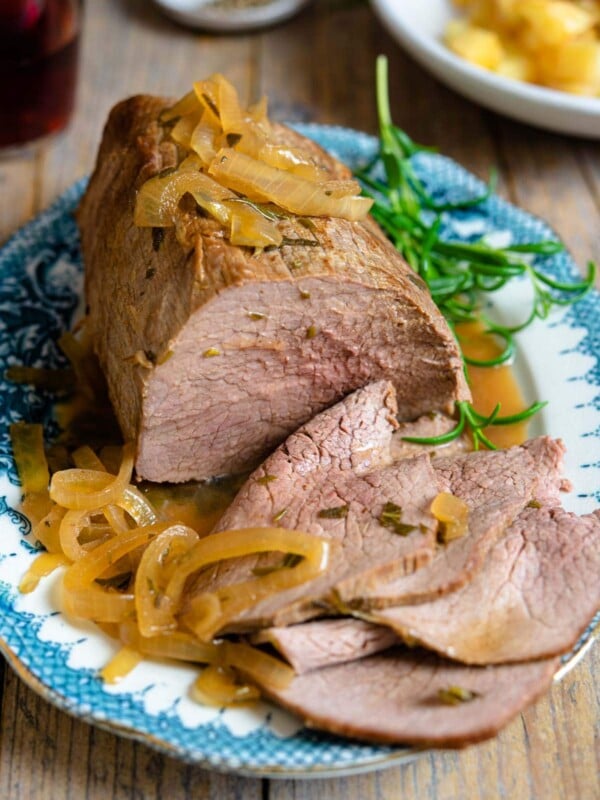
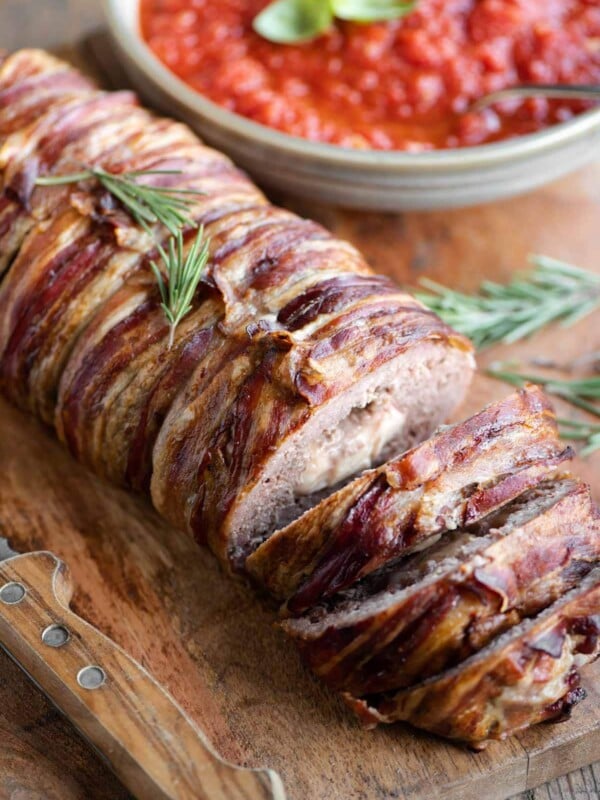
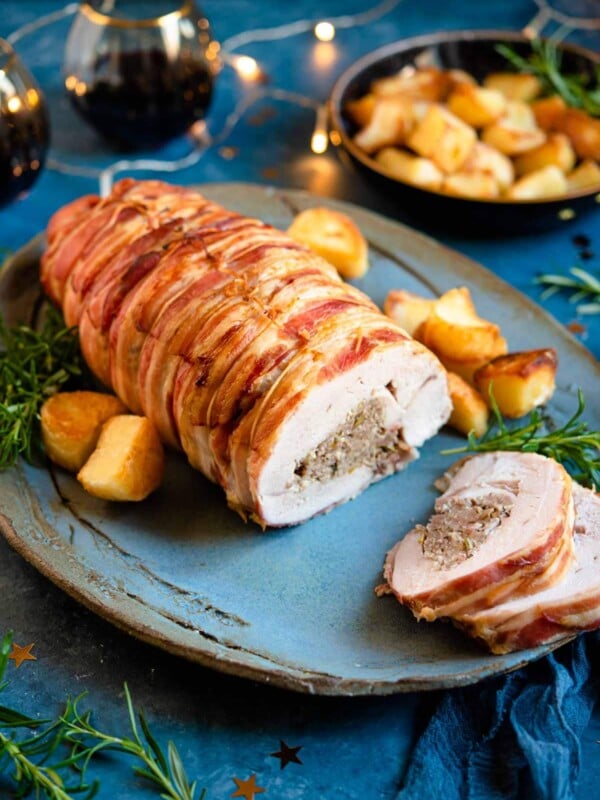
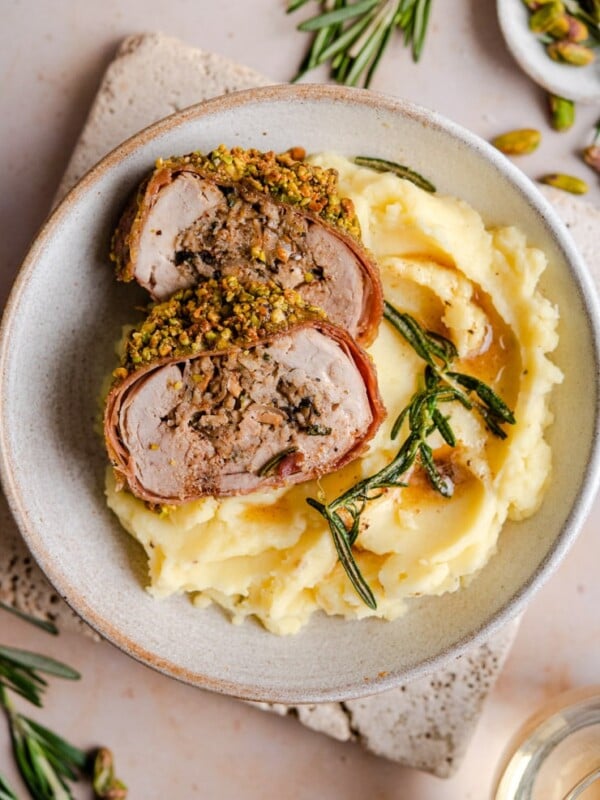
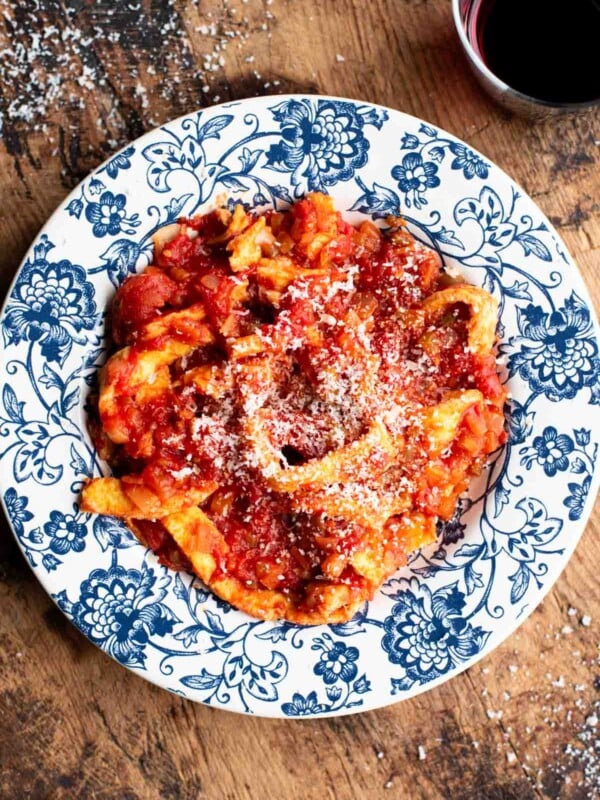
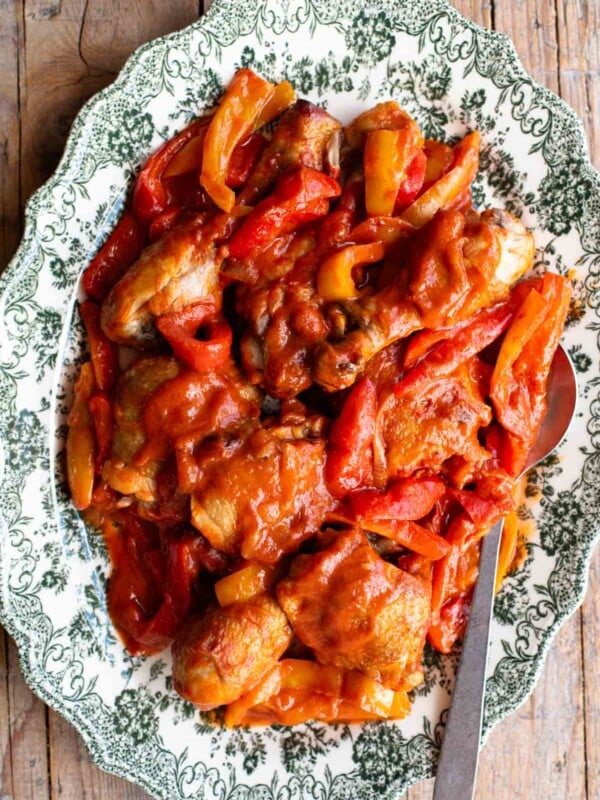
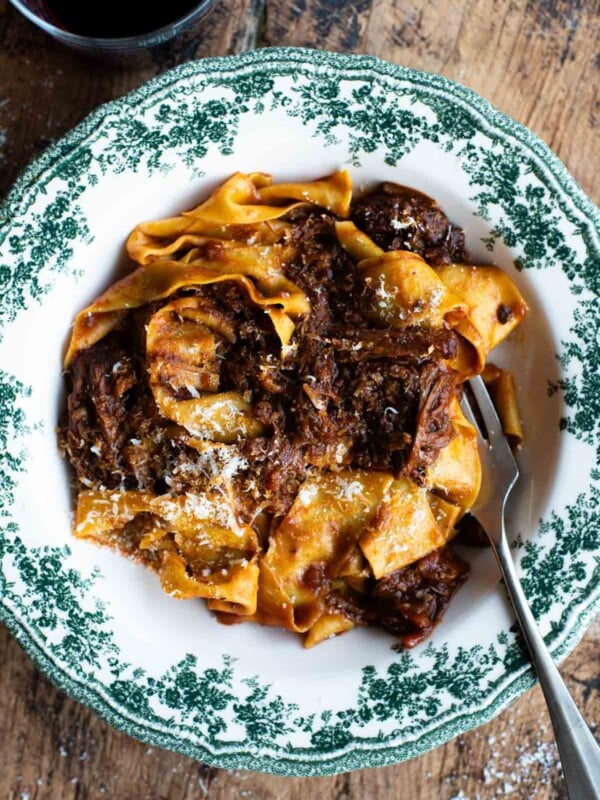
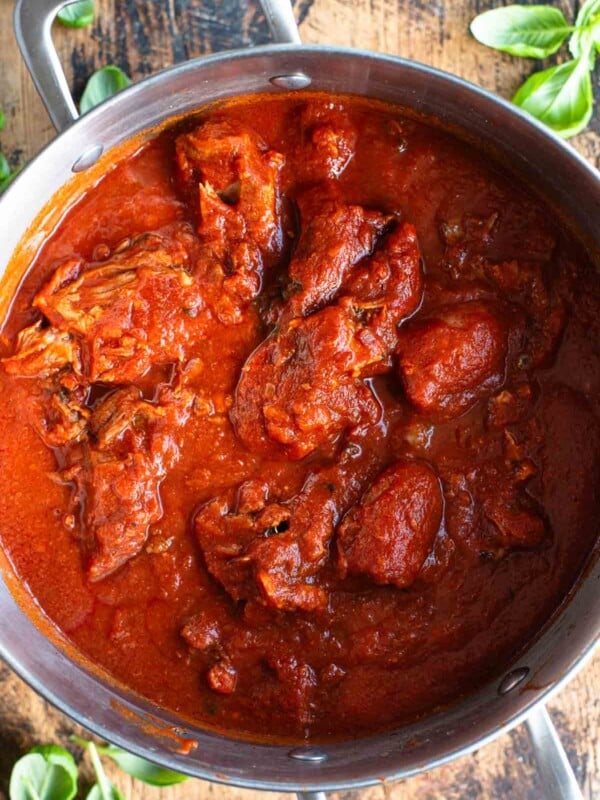









I made this recipe today and it was fantastic! It was super easy to make. I rolled the roast yesterday and let it chill out in the refrigerator allowing the flavours to infuse the meat. I inserted a probe and let it cook to 145 degrees F. Then it rested for about 25 minutes while I made the sauce. For the sauce I blitzed the onion and juices from the bottom of the pan, added a little more white wine and lemon juice and thickened it with a little roux. It was amazing served with roasted potatoes and a green salad. Thank you for such a great recipe.
Good Morning!
I have relatives from Italy visiting this summer. Is it possible to prepare this pork loin and freeze it uncooked and then cook it just before serving? I am not a fan of reheating food. Please let me know. We LOVE all your recipes.
Ciao Franca, yes that’s not a problem. Just make sure to thaw it completely before cooking. Hope you enjoy it!